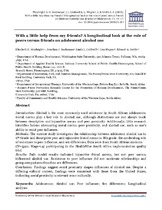With a little help from my friends? A longitudinal look at the role of peers versus friends on adolescent alcohol use
Date
2019Author
Weybright, Elizabeth H.
Beckmeyer, Jonathon J.
Caldwell, Linda L.
Wegner, Lisa
Smith, Edward A.
Metadata
Show full item recordAbstract
Introduction: Alcohol is the most commonly used substance by South African adolescents. Social
norms play a key role in alcohol use, although distinctions are not always made between descriptive
and injunctive norms and peer proximity. Additionally, little research identifies factors
attenuating social norms, peer proximity, and alcohol use, such as one's ability to resist peer
influence.
Methods: The current study investigates the relationship between adolescent alcohol use in 9th
Grade and descriptive peer and injunctive friend norms in 8th grade, the moderating role of
resistance to peer influence, and sex differences. Data were from South African students
(N=3592; Mage=14) participating in the HealthWise South Africa implementation quality
trial.
Results: Path model results indicated injunctive friend norms, but not peer norms, influenced
alcohol use. Resistance to peer influence did not moderate relationships and group comparisons
found no sex differences.
Conclusion: Findings suggest social proximity shapes influences of alcohol use. Despite a differing
cultural context, findings were consistent with those from the United States, indicating social
proximity is relevant cross-culturally.

